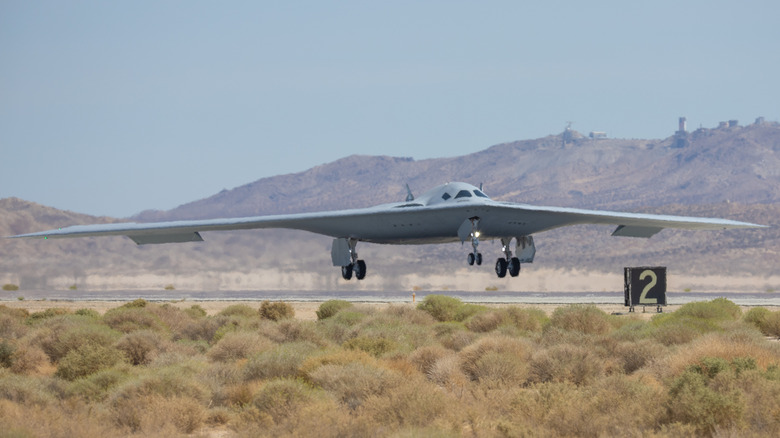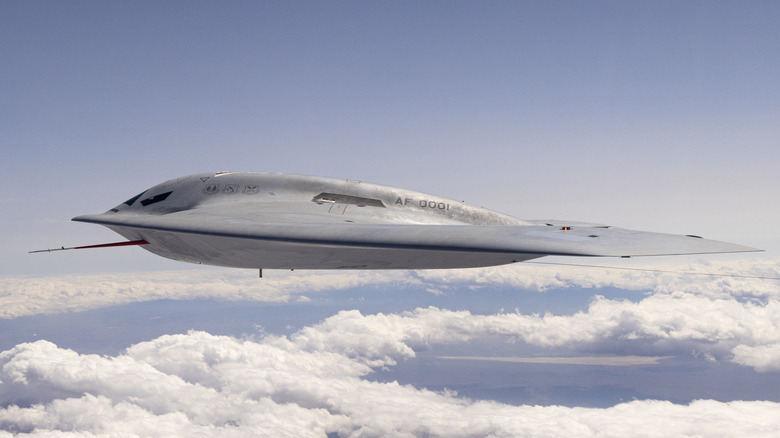Why The Air Force's B-21 Raider Stealth Bomber Is So Special Compared To Other Jets
The development and production of the U.S. Air Force's latest bomber — the Northrop Grumman B-21 Raider — recently ramped up with the delivery of a second test plane to Edwards Air Force Base in California. Visually, the B-21 could easily be mistaken for its predecessor, the B-2 Spirit, both being based on the stealthy flying wing design. However, scratch just beneath the surface, and there are some distinct differences between the B-21 and B-2. Many of these differences are what make the B-21 special when compared to other jets.
Firstly, let's look at the design philosophy behind the plane. The B-21 Raider is essentially designed to be future-proofed. The designers at Northrop Grumman took a modular approach to the project. This strategy allowed them to integrate technical standards into the design that easily and quickly allow the jet to incorporate new sensors, weapons, and advanced software algorithms — all without major re-engineering.
The B-21 is also a plane that takes to the clouds in more ways than one. Northrop Grumman and the USAF have already demonstrated how the B-21 ground systems can be migrated into the cloud, with a digital twin supporting operations while reducing the need for on-site infrastructure. Additionally, it's more than "just" a bomber; the jet can also act as an airborne command centre with the ability to control teams of drones. Of course, being a sixth-generation aircraft, these aren't the only factors that set the jet aside from others.
B-21 Raider - Stealth and survivability
The B-21 Raider is the world's first sixth-generation aircraft, a fact that instantly sets it apart from any other aircraft in today's skies. The dual-role bomber is capable of carrying both conventional and nuclear weapons, as well as controlling the aforementioned drones. The sixth-generation aspect of this plane means it has been able to lean on the lessons learned from stealth programs all the way back to the F-117 Nighthawk. For instance, the B-2 Spirit needs to be housed in an air-conditioned hangar to protect its radar-absorbent coating. Whereas the more advanced coating on the B-21 negates this requirement. Additionally, the B-21 is a smaller plane than its predecessor, which also lowers its radar profile.
Northrop Grumman also designed survivability into the B-21. Of course, its stealth characteristics are critical here — you can't shoot down what you can't see. But there's more to it than just this. The jet's advanced networking capabilities also help. The Raider's open-architecture system allows for seamless data sharing with other assets, faster maintenance, and rapid upgrades to deal with emerging threats; all of which help to ensure the aircraft can perform its mission with a minimum of risk. Ultimately, this is a plane that isn't intended to operate on the periphery of combat zones. It's a bomber that's designed to go straight to the heart of the matter, specifically designed to operate in high-threat environments and participate in challenging missions.
Cost and accountability
When it comes to judging what makes a B-21 special, the real comparison isn't with a passenger jet or a fighter but with a similar plane. The shared DNA and similarities of the B-2 Spirit make it the obvious benchmark. While we've established that the Raider is more technologically advanced than the B-2, there is another defining difference that sets the plane apart — price tag. Not by any stretch of the imagination can the B-21 bomber be called cheap, with each bomber expected to cost in the region of $692 million (in 2022 dollars). However, this pales into insignificance when compared with the almost $2 billion cost of a B-2 Spirit. Even when compared to the B-2's $1.157 billion 1998 cost, the B-21 is a relative bargain.
In terms of the differences between the planes, this means we can expect to see far greater numbers of B-21s in service. While precise numbers aren't available at this time, the USAF expects to operate a minimum inventory of 100 B-21 Raiders, with the number potentially rising as high as 150 aircraft. This would make it the most numerous bomber in the USAF arsenal, with the aging B-52 being next with 76. For comparison, the B-2 Spirit program only saw a total of 21 aircraft built, largely down to its price tag. The fact that the USAF will be able to field the Raider in real numbers is part of what will make it special amongst modern jets.


